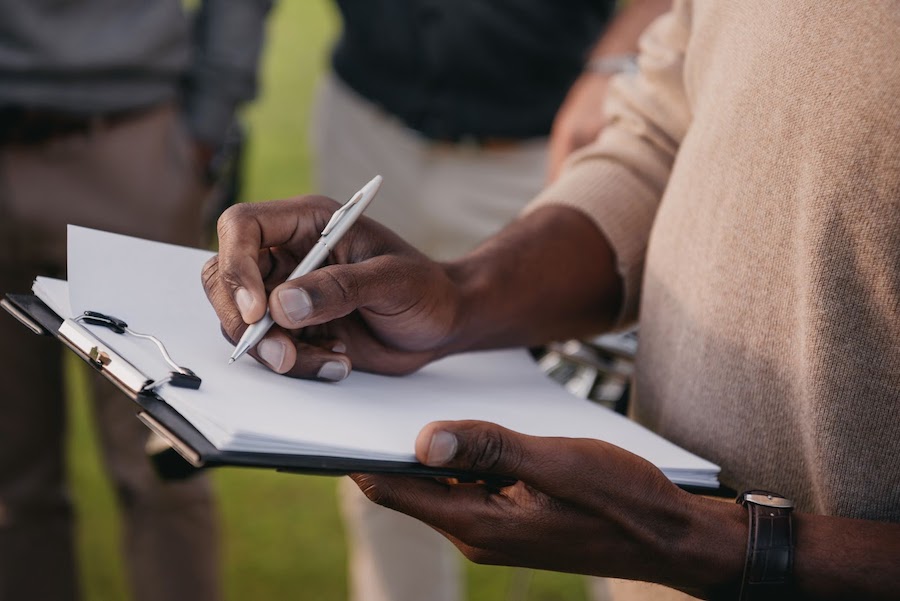Moving across the state? Or across the country? You might feel excited, nervous, or maybe a mix of the two! But whatever you’re feeling, you’re probably thinking of all the steps to get ready for your upcoming move. Any move can be challenging, but that’s especially true when you’re going a long way. Relocations over longer distances come with their own set of challenges and opportunities that go beyond packing up your belongings — you’re moving your entire life! To have a successful long-distance move, it’s important to prepare beforehand. And one of the most important ways to get ready is to prep your home for your long distance movers.
Taking steps to prepare your home before the move can make for a more efficient (and less stressful) moving day. Here are 10 steps to guide you through the process of getting ready for the big day.
Would you rather have this information in checklist form? Check out this free, downloadable Moving Checklist to help streamline your move!
Step 1: Declutter and Organize
The moving process begins with decluttering. Although it can be challenging to sort through boxes (or a whole garage!) full of items, it can actually feel freeing, lower moving costs by reducing volume, and simplify your move. Plus, this step can be started months in advance of moving day to keep it from being overwhelming.

Start by sorting your belongings into four categories: keep, donate, sell, and discard. As you’re deciding what to keep, don’t forget to consider your new location! If you’re moving to the desert, you might not need that extra snow shovel! After decluttering, organize your items into groups by room (like “bathroom”) or by their function (like “craft supplies”). This streamlines the packing process and helps movers understand where each box should go in your new home.
Step 2: Make a Detailed Inventory

Long distance movers take inventory, but it’s important for you to make an inventory of your belongings (along with their condition and value) as well! It helps you keep track of your items while you’re packing and unpacking. It can also help you identify items that are missing or damaged, and it’s useful for valuation coverage. You might take pictures and jot down notes or even take a video on your phone as you look through closets. This careful documentation is useful if there are any insurance claims, and it gives you peace of mind knowing that all your belongings are accounted for.
Step 3: Gather Moving Supplies
The right moving supplies help protect your belongings during transit. Invest in quality boxes, packing tape, bubble wrap, and other protective materials. For your fragile items, you might consider specialty packing materials (like foam inserts or packing peanuts) to provide extra cushioning. Investing in the right supplies to safely pack your belongings pays off when all your items arrive undamaged at your new home. If you’d rather not worry about proper packing techniques and materials, don’t forget that some long distance movers also offer professional packing services.
Step 4: Start Packing Early, Room by Room
Packing can be a huge task! It’s best when you can start early in an organized way. To prep your home for moving day, start packing non-essential items several weeks before the move. It’s also helpful (and less confusing!) to pack room by room. Label each box with a list of contents and the room it belongs to in your new home. Consider using color-coded labels to make the unpacking process even more efficient. Being methodical helps to reduce moving day chaos AND simplify the setup of your new home.

Step 5: Prepare Essential and Valuables Boxes
As you pack, set aside an “Essentials Box” for items you’ll need during the first few days after the move. Clothing, toiletries, medications, and crucial paperwork should all go into this box. It’s also smart to pack a separate box for valuables like jewelry, important documents, and expensive electronics. Keep these boxes with you during the move so they’re safe and easily accessible when you get to your new home.
Step 6: Prepare Furniture and Large Items
Furniture and large items require special attention during a move. Sometimes you (or your long distance movers) can disassemble items to make them easier to transport and to prevent damage. Use furniture pads or moving blankets to protect items from scratches and dings. Clearly label each piece of disassembled furniture, and keep all screws and hardware in a labeled bag. For appliances, clean and dry them thoroughly to prevent mold, and secure any loose parts with tape.
Step 7: Notify Utility Companies and Change of Address
Don’t forget to notify your utility companies and change your address! This step ensures that your services (like electricity, water, gas, internet, and mail) are transferred to your new home. Update your address with the post office, and let your bank, credit card companies, and other institutions know you’re moving. This minimizes disruptions in services and makes sure you don’t miss any important correspondence.
Step 8: Plan for Pets and Plants

If you have pets, make sure they’re prepared for the move, too! Moving can be stressful for your furry friends, so keep their routine as normal as possible leading up to moving day. On moving day, there will be lots of doors open and people coming and going. Make sure pets are secured while the long distance movers are there, and create a safe and comfortable space for your animals during transport.
For plants, consider the climate they’ll face during the move and in your new home. If certain plants are unlikely to survive the journey, it may be best to give them to friends or family.
Step 9: Confirm Moving Details With the Movers
In the days leading up to your move, confirm all arrangements with the moving company. Double-check your moving plan, including the date, time, and any special instructions for handling your items. Your movers should go over this information with you and make sure everyone understands the insurance coverage provided for your belongings. Clear communication is the name of the game for a smooth moving day.
Step 10: Clean and Inspect the Home Before You Leave
After your belongings are packed and loaded onto the moving truck, clean your home or hire professional cleaners to do it for you. This step is particularly important if you’re renting and hope to get your security deposit back. Once the house is clean, do a final walkthrough to make sure nothing has been left behind. Take photos of the empty rooms as a record of the condition you left the property in.

After the House Is Prepped, Your Long Distance Movers Take It From There
Preparing for a long-distance move can be complicated, but having a detailed plan and checklist can really help to manage it effectively. By following these steps, you can make your move as stress-free as possible and begin your new adventure with confidence and peace of mind.
Still have questions? Here are some FAQs that might help!
Why use a moving checklist?
When you’re planning a move, a moving checklist can make the process more organized, efficient, and less stressful. It provides a clear outline of things you need to do (and when!), so that you stay on track and don’t overlook important steps. Here’s a free, printable moving checklist that can help during the moving process.
How do I make a moving plan?
To make a moving plan, start by talking with a trustworthy moving company as soon as possible to get a quote, secure a moving date, and establish a moving timeline that meets your needs. When you hire a reliable moving partner, they’ll help you figure out details and logistics. Here is a moving checklist to help you plan your move, from two months before through moving day.
How long does it take to prepare for a move?
Ideally, it’s good to start preparing for a move 2-3 months in advance for a moderate-sized home. This period allows for sorting, decluttering, packing, and handling necessary administrative tasks without rushing. Larger homes, longer distances to move, and busier schedules may require additional time. Starting early can help ensure a smoother, less stressful move. However, we’ll help you find solutions that meet your needs regardless of the timeframe. If you’d like more information about how long it takes to move, check out this article
What are things to keep out when packing to move?
When packing for a move, set aside a box or suitcase for essentials: important documents, daily toiletries, a few sets of clothes, medicines, chargers, and necessary items for kids and pets. You might keep basic kitchen items like a coffee maker and some cutlery out for quick meals, as well as cleaning supplies for tidying up. Also, pack a “first-night” bag with bedding and snacks to help you settle in comfortably on arrival without having to dig through boxes. These essentials can help keep you functioning smoothly during the move.
Want to find out more about getting your home ready for moving day? Contact us today to speak with one of our moving experts!


